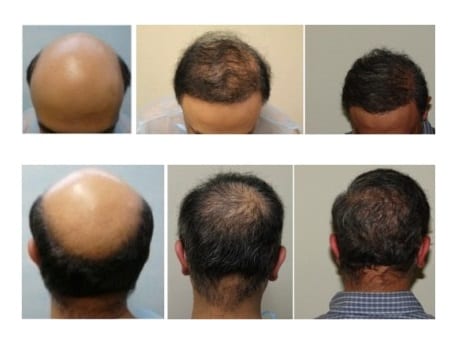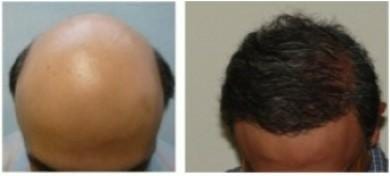2022 Hair Cloning Update
In January 2022, MIT Technology Review states how human hair cells are being grown in the lab and tested on animals. For example, a startup called dNovo recently sent a photograph of a mouse with a sprout of a “dense clump of human hair.” This resulted from a transplant of human hair stem cells, as reported by company ambassadors. “reprogramming” ordinary cells such as blood or fat cells may be a new technology that could potentially help target the “underlying cause of hair loss.”
2021 Hair Cloning Update
In February 2021, Japanese scientist Tsuji from the Riken Institute published a new hair cloning study, “Expansion and Characterization of Epithelial Stem Cells With Potential For Cyclical Hair Regeneration,” in Nature Scientific Reports.
Tsuji and his team identified a specific type of hair follicle stem cell capable of creating “cloned” hair follicles with hair cycle phases (i.e., anagen, catagen, and telogen) that grow and shed hair shafts.
However, can these new hair follicles produce hair that grows in appropriate directions? In 2019, hair scientists started to explore the possibility of using 3D printed shafts to help “follicles growing upward through the scalp.” This approach is intended to help solve the issue of lab-generated follicles growing hair in different directions.
This methodology requires further research before it is made available to the public for commercial use.
Hair Cloning As A Source of Hope For Hair Loss Sufferers
-

Doctors hope that hair cell cloning will one day become a reality. Until then, Dr. UGraft’s head hair transplant offered this patient a good head of hair when conventional methods could not.*
Is Hair Multiplication A Reality in 2020?
Hair multiplication, also known as hair cloning, has no standard method. Despite the 15 years of research by several scientists and institutions, the technology is still in its early stages.
The concept of hair cloning is the same across the board. It focuses on the ability to use existing hair follicles to create new follicles that multiply and grow. Another focus is on the use of hair follicle stem cells. Similarly, the ultimate promise of hair cloning is unlimited hair. Theoretically, hair follicles can be multiplied when it comes to hair cloning.
The Hair Cloning Claims
While several practitioners and institutions, primarily overseas, allege they’ve cracked into the innovative hair cloning technology, it’s not true. Despite the deceptive claims, no breakthrough new treatment for hair loss using hair follicles multiplied.
Because the laws are loose or nonexistent in some countries, their allegations of multiplication are erroneous and misleading. Meanwhile, Dr. Umar explained that the U.S., the Food and Drug Administration, FDA, the Federal Trade Commission, and FTC actively monitor and prosecute false and fraudulent medical claims.
“There are several hurdles researchers have to overcome before hair cloning becomes available to humans,” Dr. Sanusi Umar of Dr. U Hair and Skin in Manhattan Beach, Calif., said.
Popular Ways to Treat Thinning and Balding Hair
There are three ways to treat thinning hair and balding heads:
- FDA-approved medications like Minoxidil and finasteride.
- Hair tonics and other natural hair products like Dr.UGro Gashee.
- Hair transplants have provided patients with long-lasting results.
Anyone claiming hair multiplication, cloning, or restoration outside the current treatment options is evil and lying. “Beware,” Dr. Umar said. “People have been swindled.”
Hair Multiplication 2020 Status
In early March, a Japanese company, Shiseido’s lead researcher, Dr. Ryoji Tsuboi, from Tokyo Medical University, released the latest clinical study on the safety and effectiveness of cell therapy technology or cell-based therapies using autologous or allogeneic cells used clinically for thinning hair.
Stem cell hair transplants are similar to current hair transplant procedures. The striking difference is that the follicles are replicated in a lab and then transplanted back onto the scalp in the balding areas. Furthermore, the transplanted hair, as well as the donor hair follicle, will grow.
According to Tsuboi’s open statements to the media in the native Japanese language, the study treated male and female pattern hair loss between ages 33-64. Tsuboi’s report said the research entailed injecting autologous cell-based therapy (a patient’s cells) and dermal sheath cups, DSC, cells surrounding the dermal papilla, DP. The results were positive but only lasted six to nine months after treatment.
“The result of our study was very encouraging,” Tsuboi said. “We were able to show that the study could help develop a new treatment for hair loss.”
As to “when the technology will be available to practice,” – there’s no official timeline or date.
“We don’t know when hair cloning will become a reality,” Dr. Umar said. “but it’s coming.”
Understanding Controlled Hair Cloning Research Methods: Cells Used For hair Multiplication Research Purposes
Two Types of Cells are primarily used by researchers in their pursuit of hair follicle cloning. Scientists hope that by better understanding these cells, they may one day be able to clone hair:
- Dermal papilla – DP cells are used to induce precursor cells to form hair follicles
- Keratinocyte-based precursor cells which, upon induction (Typically by DP cells or other factors), form hair follicles
- However, other hair follicle cells and even non-hair follicle-based cells are assuming the increasing position of importance in the science of hair cloning

Dermal Papilla Cells: Located at the bottom of hair follicles, dermal papilla cells can stimulate other cells to form hair follicles. In the normal hair cycle, DP cells induce hair stem cells located in the upper 1/3rd portion of the hair follicle called the hair bulge to regenerate and grow new hair follicles. Hair cycles through three phases:
- Anagen – the growing phase that produces many follicles.
- Telogen – is also the resting phase in which hair does not grow.
- Catagen – a period where follicles are sparse and hair regresses.
Follicles go through stages of rest and regression in which hair growth does not occur. However, stem cells in the bulge area remain intact through all cycle phases. At the end of the test phase, these stem cells are induced by adjoining dermal papillae cells to create and grow new hair shafts. Researchers are capable of extracting these DP cells even during catagen. Dermal papillae migrate upwards when hair recedes. Eventually, the cells come to rest next to the stem cells of hair follicles’ bulge, where they cause the induction of new hair formation to mark the onset of anagen. There is also the understanding that stem cells in the bulge can migrate to the dermal papillae cells’ location to get induced. Either way, DP’s role in inducing the stem cells to form new hair shafts is not disputed.
While it is true that dermal papillae cells do survive through catagen, they only induce stem cells to grow new hair shafts during the anagen stage of growth. Dp cells’ signal to induce new hair cell formation by the stem cells comes from the dermal sheaths and neighboring cells.
Keratinocyte-based cells: Keratinocytes are epidermal cells that create keratin. Keratin is a protein that serves as the main ingredient in hair strands. Research has sown that dermal papillae cells can induce keratinocytes to create new follicles when nurtured in a laboratory setting.
Hair Cell Cloning and Hair Multiplication Research Challenges
Hair cloning and multiplication researchers greatly enthusiasm keratinocyte and dermal papilla cells. Ongoing research suggests hair multiplication by cloning may one day become a treatment for hair loss. Scientists could help thousands of individuals experiencing severe balding (Norwood Scale 6-7 categories) if they find a way to extract, develop, and maintain the cells long enough to perform hair restoration surgery. Once this barrier is overcome, hair transplant via cloning may become a reality.
Unfortunately, researchers have several hurdles to overcome before the method can become feasible. Some of the challenges include:
- Dermal papilla cells behave differently when in the lab. Though the cells stimulate growth, one with the scalp loses its inductive properties after a few takes in the lab.
- When DP cells induce precursor cells, they can form other tissues that are not hair. Recently, however, Dr. Jahoda and coworkers 2013 published their findings, proving that when DP cells and precursor cells are placed into a spherical three-dimensional 3D configuration that mimics a hair bulb, the formation of hair follicles occurs more consistently.
- When hair-inducing cells injection into the scalp results in the induction of new hair growth, the new hair is incapable of successfully surviving multiple hair cycles, which are required for the result to be viable.
- When DP cells are injected into the scalp result in hair growth, the challenge of uncontrolled hair direction is yet to be solved. Attempts to introduce the cells in absorbable follicle casts have been entertained.
- When injected into the bald area of the donor area, cells do not guarantee good growth patterns. An unnatural appearance can result when restoring by way of hair cloning because of a physician’s inability to determine where hair follicles will grow.
- Patients can have an allergic reaction during or after the procedure. Scientists have yet to determine the effects of injecting dermal papillae for hair growth.
Partial FUE Hair Transplant ( PFUE ) is Not Hair Multiplication or Hair Cloning
Patients undergo a hair transplant hoping to have hair. Willing to try anything in the name of their precious locks, some are eager to buy into the science of hair cloning with expectations that it will produce new hairs that no longer exist or exist.
Dr. Umar shared he was skeptical when learning about some centers’ claims of achieving hair multiplication through Follicular Unit Extraction, FUE. Once he reviewed the publications from such institutions, he determined they were practicing Partial Follicular Unit Extraction, PFUE. “A PFUE is not considered hair cloning,” he explained.
According to Dr. Umar, some practitioners practicing PFUE are merely using very small FUE punches to split the hair into two longitudinally. The small FUE creates more minor wounds that heal better and quicker. This also results in getting a two hair follicle, sometimes even a three hair follicle, to grow in donor areas as a single hair and another in the bald area. The problem is that this procedure created NO “new” hair follicles. In other words, no hair multiplication has happened.
A PFUE is a blind process that increases the risk of follicle damage and no growth in the donor or recipient area. Consequently, a patient could lose a substantial amount of their donor’s hair and end up with skinny, poor coverage in the recipient area.
“When you do small punches like that, ranging at the 0.6 0.5 millimeters,” Dr. Umar explained. “You’re going to have skinny coverage on your head, and you’re going to have premature and severe donor depletion.”
One of Dr. Umar’s patients came to him after two unsuccessful FUE procedures with small punches. “The donor area was depleted, and the coverage was insufficient,” he said. “We had to look into body hair transplantation to make up for what was unnecessary and should not have happened.”
There have been claims by some centers of achieving hair multiplication through FUE. After reviewing the publications from these institutions, Dr. Umar believes that what they are practicing is partial follicular unit extraction (PFUE) which entails using very small FUE punches to split the hair into two longitudinally with the hope of creating more minor wounds that heal better and getting a two hair follicle to grow in the donor areas a single hair follicle and another in the bald area. The problem is
- No new hair follicle has been created. Hence no hair multiplication or hair cloning has occurred, making such claims misleading and potentially fraudulent.
- There is a very high likelihood that the split follicle does not survive in both areas since the PFUE is a blind process. There is a higher chance that the follicle is damaged entirely or partially, resulting in no growth in either donor or recipient. In other words, the patient would lose many head donors and skinny (poor) coverage in the recipient area. The patient would have more minor wounds that heal better, though. However, patients go into a transplant hoping to have hair.
The science of cloning automatically brings to mind double sheep (Dolly) and cows. Hair Cloning and Hair Multiplication have been used interchangeably since both transplants attempt to produce new hairs that never existed.
Dr. U has well explained these thoughts in this video:
Is Hair Multiplication a Reality?
Many hair loss sufferers are interested in knowing whether or not hair multiplication offers a legitimate form of treatment of not. In this video, Dr. U offe…
Hair Cloning Prides Hope For The Future; for Those Interested In Hair Now, Dr.UGraft Offers Hope For Even The Severely bald.
Doctor Sanusi Umar has spent most of his extensive medical career researching hair loss. He has seen everything from mild hair loss to severe balding and embraces every challenge that comes his way. Dr. Umar understands that transplants need to look natural. By developing Dr.UGraft Zeus FUE system that safely removes both head and non-head hair, including beard and body hair, he has vastly expanded the patient’s available donor hair. The Dr.UGraft technology developed by Dr.U makes it possible to achieve a good head of hair in even significantly bald patients and patients with severe head donor depletion resulting in past surgical mistakes.
-

Until Cloning hair follicles become a reality, Dr. UGraft’s head and body transplant methods offer a way to treat severe hair loss.*
Why Hair Cloning Candidates Of The Future Should Consider Advanced Dr.UGraft Solutions Now:
- Dr.UGraft allows for the extraction of thousands of follicles for hair restoration. Dr. Umar can extract as many as 20,000 grafts from the donor areas of the head, beard, and body, making it possible to restore fully patients that would have hitherto had no chance but to wait for the not-yet-available hair cloning breakthrough treatment.
- Dr.UGraft allows for selecting the most suitable hairs for achieving specific purposes in ways traditional hair transplants cannot. For instance, using more delicate leg hairs to achieve near-perfect soft-looking temple points, eyebrows, etc.
So why wait for something that may or may not manifest safely in the future, which the current state of hair cloning research is currently. Why not live here and now and consult Dr. U even if you have severe baldness and have been told there is no hope?
Hair Cloning Frequently Asked Questions:
So when will hair cloning be available? How much will hair cloning cost?
At present, nobody can say for sure. Scientists continue to research hair follicle cloning. Given its explosive nature, it would be very quickly known if the breakthrough occurred.
I understand cloning hair isn’t yet possible; since I have severe baldness with a limited donor, is there a method whereby I can still restore my hair to look natural and healthy?
Yes! Dr.UGraft FUE allows a doctor to expand your donor supply by the ability to extract hair from anywhere on the head, beard, and body and transplant it to severely bald heads. This method allows Dr. Umar to tailor hair growth to different densities and shapes. He uses follicles from all over the body of different thicknesses and coarseness. The Dr.UGraft FUE method’s versatility allows for a reconstructed hairline using real hair, which looks natural.
When will hair cloning be available, and how much will it cost?
Nothing is set in stone. Hair cloning is still a technology in its research phase. Despite some advances, there hasn’t been a reliable breakthrough.
What if I have severe baldness with limited donor hair and need something like hair cloning? Can I still restore my hair?
Since there is no established hair cloning/multiplication practice, it wouldn’t be an option. But there are current FDA-approved treatments such as Minoxidil, finasteride, and low-level lasers that can help with earlier levels of baldness. In more severe cases, some patients have opted for hair transplants. At Dr. U Hair and Skin Clinic, Dr. U uses the advanced hair transplant system – Dr. UGraft Zeus ™, which can extract hair from anywhere on the head, beard, and body transplanting. Because of the advanced Follicular Unit Extraction hair transplant devices, Dr. Umar can tailor the hair’s growth, density, and shape – and still provide patients with the most natural look.
Have I heard about hair transplantation for hair multiplication involving stem cells? Is this a reality?
There are misleading claims of this nature from overseas (Europe and Asia) where lax laws allow such misleading claims to stand. Thus far, there have been no proven results, and these claims are misleading and fraudulent. It is not viable enough to warrant it being projected as a solution to hair loss. See the video above in which Dr. U explains further on this subject.
Have more questions about hair? Use the button below to schedule a free hair consultation now.
Further Reading:
- More about Dr.UGraft Advanced body hair transplantation
- Study on body hair transplantation publication in the Aesthetic Surgery Journal.
References:
- Regalado A. Going Bald? Lab-grown hair cells could be on the way. MIT Technology Review. https://www.technologyreview.com/2022/01/18/1043751/bald-lab-grown-hair-cells/. Published May 11, 2022. Accessed July 7, 2022.
- Hair cloning. Wikipedia. https://en.wikipedia.org/wiki/Hair_cloning. Published April 13, 2022. Accessed July 7, 2022.
- Slezak M. 3D drops raise hopes of a cure for baldness. New Scientist. https://www.newscientist.com/article/dn24445-3d-drops-raise-hopes-of-cure-for-baldness/. Published October 21, 2013. Accessed July 7, 2022.
- Umar S. Body hair transplant by follicular unit extraction: My experience with 122 patients. OUP Academic. https://academic.oup.com/asj/article/36/10/1101/2664510?login=false. Published May 30, 2016. Accessed July 7, 2022.
